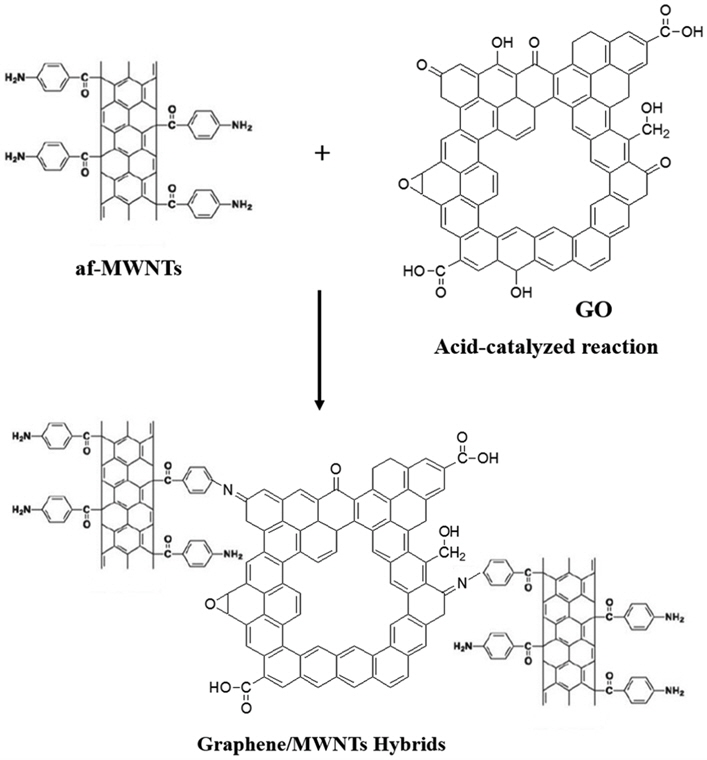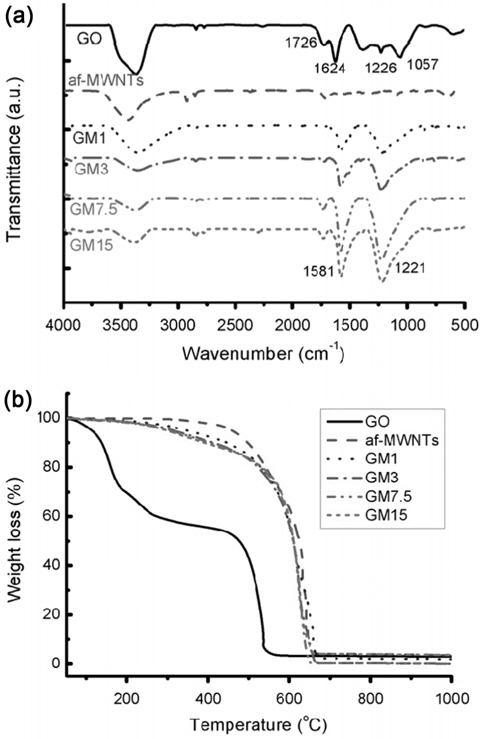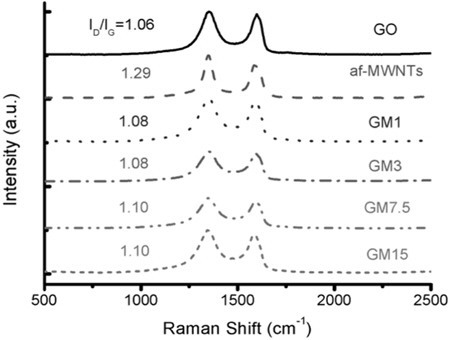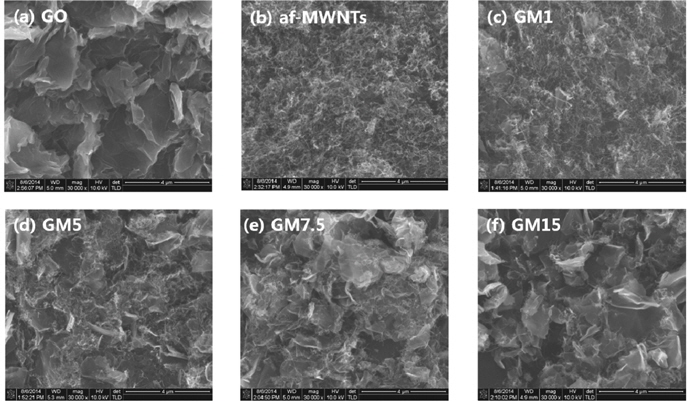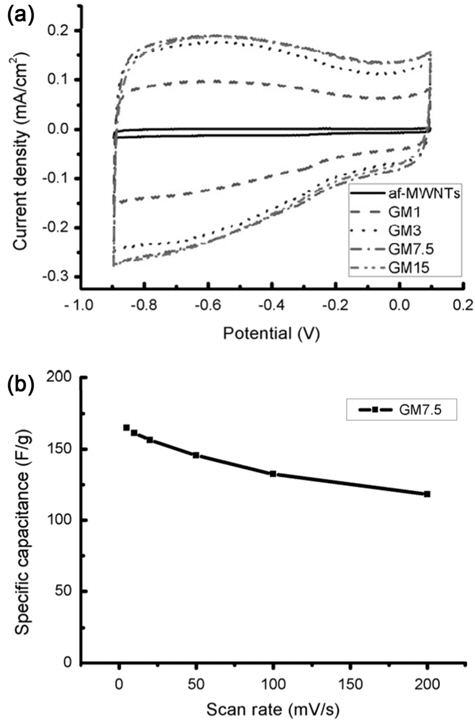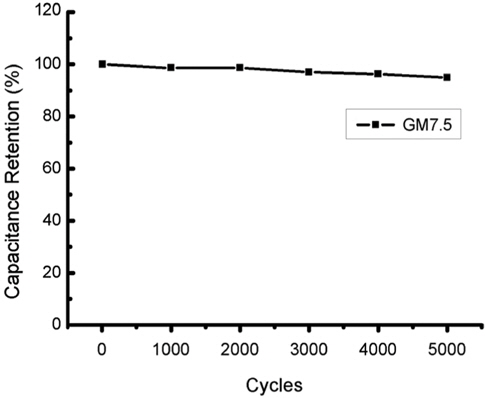



본 연구에서는 그래핀과 다중벽 탄소나노튜브를 포함하는 하이브리드 소재의 제조 및 슈퍼캐패시터 전극물질로의 활용에 관한 내용이 진행되었다. 이를 위하여 산화그래핀과 아민(-NH2) 그룹이 치환된 다중벽 탄소나노튜브를 산 촉매 하에서 반응시켜, 새로운 이민(-C=N-) 결합이 도입된 하이브리드 복합체를 합성하였다. 상기 제조된 하이브리드 소재를 슈퍼캐패시터 전극 물질로 사용하고자 수산화칼륨 전해질 기반의 3상 전극 시스템을 활용하여 전기화학적 특성을 살펴보았다. 또한 하이브리드 소재에 존재하는 그래핀과 다중벽 탄소나노튜브의 비율 변화 실험을 통하여, 그래핀/탄소나노튜브의 질량비가 7.5/1일 때 그 특성이 최적화가 됨을 알 수 있었다. 최적화된 전극은 높은 비축천용량(132 F/g)을 나타내었을 뿐만 아니라, 반복된 충방전 실험에서 높은 안정성(95%, retention after 5000 cycles)을 나타내었다.
Owing to increasing demands for the development of clean and renewable energy resources in order to solve emerging energy-related problems, various energy conversion and storage systems such as solar cells, fuel cells, lithium-ion batteries, and supercapacitors have attracted a great deal of interest in both academia and industry [1-3]. In particular, supercapacitors, also known as ultracapacitors or electrochemical capacitors, have become of great importance. This is because of their great potential as electrical storage units in portable electronic devices and electric vehicles, owing to their superior power density, high charge/discharge rate, and enhanced cycle life [4,5]. Based on their energy storage mechanism, supercapacitors can be categorized into three types: (i) electrical double-layer capacitors (EDLCs), in which the electrostatic charge is accumulated on the surface of the electrode by the formation of an electrical double-layer, (ii) pseudocapacitors with fast and reversible Faradaic charge transfer processes on or near the electrode surface, and (iii) hybrid capacitors in which the EDLCs and pseudocapacitors can work together. In general, carbon-based nanomaterials with a high specific surface area, for example, activated carbon, carbon nanotubes (CNTs), and graphene, have been widely used in EDLCs [4]. This is because the surface area of the electrode plays an important role in the performance of EDLCs. Furthermore, composite electrodes composed of carbonbased nanomaterials, together with conducting polymers or metal oxides have usually been applied to pseudocapacitors [4].
Among various carbon-based nanomaterials, graphene, as a two-dimensional single layer of graphite with carbon networks, has emerged as an ideal electrode for supercapacitors. This is because of its high specific surface area, excellent electron mobility, and superior mechanical properties [6]. Although the theoretical maximum double-layer capacitance of graphene can attain a value of up to 550 F/g [4], most graphene-based supercapacitors have limited capacitances. This is because of the structural and morphological defects of graphene sheets, such as the significant reduction in electrical conductivity and the ease of formation of large clusters, with reduced specific surface area. To solve these problems, the incorporation of CNTs into graphene networks has been suggested by several researchers [7-10]. In this condition, the significant reduction of electrical conductivity in graphene networks can be considerably minimized and the restacking of graphene sheets can be efficiently prevented by CNTs. However, most graphene/CNTs composites are prepared by physical adsorption or electrostatic forces, in which the interactions between graphene and CNTs are relatively weak and unstable. Therefore, it is necessary to develop alternative methods in order to enhance their relationship within composites.
Herein, we report a versatile and scalable approach to produce graphene-based hybrid materials for supercapacitors, using graphene oxide (GO) and 4-aminobenzoyl functionalized multiwalled carbon nanotubes (af-MWNTs) as precursors. GO and af-MWNTs are chemically connected by newly formed imine linkage (-C=N-) during the acid-catalyzed dehydration reaction between ketone (C=O) groups in GO and primary amine (-NH2) in af-MWNTs (Figure 1). In addition, GO can be readily reduced to restore the graphitic structure during the acid-catalyzed reaction at high temperature. The chemical structures of graphene/MWNTs hybrid materials have been confirmed by various microscopic and spectroscopic analyses. Furthermore, the weight ratio of graphene/MWNTs in hybrid materials can be simply controlled by changing the initial feed ratio. The optimum weight ratio is determined to be 7.5/1. The resultant hybrid materials demonstrated not only improved thermal stability but also superior capacitance with long-term stability.
Graphite nanopowders (450 nm APS, 99.9% purity) were obtained from Nanostructured and Amorphous Materials Inc., and were used as a starting material. Firstly, GO was prepared from graphite nanopowders, using a modified Hummer’s method [11]. The af-MWNTs were synthesized according to procedures in literature [12]. Subsequently, GO (300 mg) and varied amounts of af-MWNTs, ranging from 20 mg to 300 mg, were reacted to produce graphene/MWNTs hybrid materials; these were designated as GM1, GM3, GM7.5, and GM15 (the numbers denote the weight ratio between GO and af-MWNTs, and the higher the number, the larger the amount of graphene). The amount of af-MWNTs for the preparation of the GM1, GM3, GM7.5, and GM15 materials was 300 mg, 100 mg, 40 mg, and 20 mg, respectively. The experimental procedures are described as follows; GO and af-MWNTs were dispersed in a dimethylformamide (40 ml)/acetic acid (20 ml) mixture under sonication for 1 h. Subsequently, the mixture was reacted with continuous stirring at 110 ℃ for 24 h. On cooling to room temperature, the reaction mixture was filtered with a nylon membrane (0.45 μm) and washed several times with methanol and water. The resultant hybrid materials were further purified by Soxhlet extraction with water, THF, and methanol. Finally, hybrid materials were obtained as a black powder after vacuum drying at 50 ℃ overnight.
Elemental analysis (EA) was conducted with a Thermo Scientific Flash 2000. Fourier transform infrared (FT-IR) spectroscopy was performed on a Perkin-Elmer Spectrum 100 using KBr pellets. Themogravimetric analysis (TGA) was performed with a TA Q200 (TA Instrument) at a heating rate of 10 ℃ min−1, in air. Raman spectra were obtained by confocal Raman microscopy (Alpha 300S, WITec, Germany), in conjunction with atomic force microscopy (AFM) with a He-Ne laser (532 nm) as the excitation source. The field emission scanning electron microscopy (FE-SEM) was performed using a FEI Nanonova 230. Cyclic voltammetry (CV) analyses were conducted using a potentiostat (IVIUM CompactStat, IVIUM Technologies) with a standard three-electrode cell. Glassy carbon electrodes coated with hybrid materials were used as working electrodes. A platinum wire and an Ag/AgCl (3M NaCl filled) electrode were used as a counter and reference electrode, respectively.
Elemental analyses (EAs) were conducted to investigate the chemical compositions of all samples (
[Table 1.] Summary of elemental analyses of GO, af-MWNTs, GM1, GM3, GM7.5, and GM15
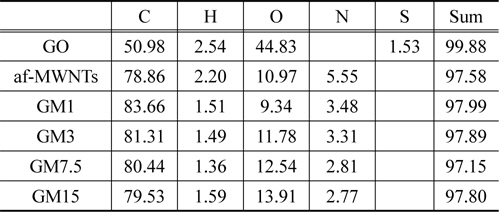
Summary of elemental analyses of GO, af-MWNTs, GM1, GM3, GM7.5, and GM15
FT-IR measurements using KBr pellets were also conducted to investigate the structural changes prior to and after the reactions. Typically, a sp3C-H peak at 2920 cm−1 and a carbonyl peak at 1707 cm−1 have been observed in af-MWNTs. In addition, GO shows several peaks from various oxygenated functionalities at 1726 (
The thermal stability of all samples was examined by thermogravimetric analysis (TGA). As demonstrated in Figure 2(b), af-MWNTs start to decompose at 450 ℃, while GO exhibits a drastic thermal decomposition near 200 ℃, due to the presence of large amounts of oxygenated functionalities. Surprisingly, all hybrid materials show improved thermal stability regardless of the weight ratio between graphene and MWNTs. This can be attributed to the efficient restoration of the graphitic structure by the removal of various oxygenated groups as well as the formation of imine linkage during acid-catalyzed reactions. These results reveal, once again, that the acid-catalyzed reaction used in this study is beneficial to the production of high quality graphene/MWNTs hybrid materials.
Raman spectra obtained from all the powder samples are shown in Figure 3. The broad and strong D band at 1353 cm−1 and G band at 1590 cm−1 were clearly observed in GO and af-MWNTs. The ratio of the intensity of the D and G bands (ID/IG) can attain values up to 1.06 and 1.24 for GO and af-MWNTs, respectively. This is due to the large structural distortion and the reduction in size of the sp2 domains [16]. Similarly, all graphene/MWNTs hybrid materials show D and G bands at 1352 and 1590 cm−1, respectively, with a relatively high ID/IG ratio of 1.10. This indicates the presence of disordered graphitic structures within the hybrid materials. However, the almost identical value of the ID/IG ratio reveals that the amount of af-MWNTs on graphene does not introduce a noticeable amount of defects in hybrid materials.
Raman spectra obtained from all the powder samples are shown in Figure 3. The broad and strong D band at 1353 cm−1 and G band at 1590 cm−1 were clearly observed in GO and af-MWNTs. The ratio of the intensity of the D and G bands (ID/IG) can attain values up to 1.06 and 1.24 for GO and af-MWNTs, respectively. This is due to the large structural distortion and the reduction in size of the sp2 domains [16]. Similarly, all graphene/MWNTs hybrid materials show D and G bands at 1352 and 1590 cm−1, respectively, with a relatively high ID/IG ratio of 1.10. This indicates the presence of disordered graphitic structures within the hybrid materials. However, the almost identical value of the ID/IG ratio reveals that the amount of af-MWNTs on graphene does not introduce a noticeable amount of defects in hybrid materials.
SEM measurements were performed to investigate the morphological and micro-structural changes during the formation of hybrid materials. The unique densely packed sheets of GO and tubular structures of af-MWNTs can be observed in Figure 4(a) and 4(b), respectively. The entangled MWNTs in good contact with the graphene sheets, in addition to the wrinkled paper-like structures with relatively high electron transparency, appear in the SEM images of the hybrid materials (Figure 4(c)-(f)). In addition, the quantity of MWNTs in hybrid materials is almost disproportional to the weight ratio of graphene/MWNTs. Therefore, the SEM images clearly demonstrate that the chemically linked MWNTs on the graphene surface act as a spacer material to prevent the undesirable coalescence of graphene sheets and it also facilitates the control of MWNTs content within the hybrid materials.
To investigate the electrochemical performance of hybrid materials as electrodes in supercapacitors, cyclovoltametric (CV) analyses were conducted in 1 M KOH solution, using a standard three-electrode cell. As demonstrated in Figure 5(a) and Table 2, all hybrid materials exhibit an enhanced current density when compared with af-MWNTs, implying a larger specific capacitance. In addition, the CV curves of the hybrid materials were of almost rectangular geometry, which implies a low contact resistance during CV measurements. However, a significant reduction in capacitance was observed in the hybrid materials with a lower weight ratio of graphene,

Capacitance of af-MWNTs, GM1, GM3, GM7.5, and GM15 in 1 M KOH solution at a scan rate of 100 mV/s.
The cyclic stability of hybrid materials as electrodes in supercapacitors was also evaluated by operating the electrochemical cell at a scan rate of 100 mV/s for 5000 cycles. As shown in Figure 6, the specific capacitance of the GM7.5 material demonstrates excellent stability during all cycles, and the retention of the initial capacity can reach up to 95%, even after 5000 cycles. This high retention value of the hybrid materials originates from the efficient prevention of the selling and shrinkage of the electrode during the charge-discharge process, owing to the highly stable chemical linkages between graphene and af-MWNTs in the hybrid materials.
We have developed a simple, but efficient method to produce graphene/MWNTs hybrid materials
